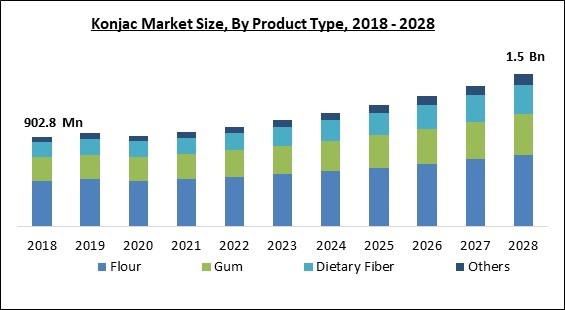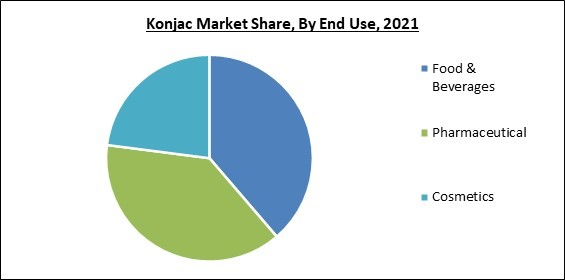The Global Konjac Market size is expected to reach $1.5 billion by 2028, rising at a market growth of 7.4% CAGR during the forecast period.
Konjac is a root vegetable with just an irregularly shaped potato shape. The underground component of the plant is known as the bulb, which contains a soluble fiber called glucomannan. Soluble fiber absorbs water and generates a gel-like compound that obstructs digestion. It can help to lower glucose and cholesterol levels in the blood. Soluble fiber can be found in citrus fruits, beans, oats, carrots, apples, and psyllium.
Konjac is a plant with a starchy corm that is high in glucomannan, a type of dietary fiber. The dried stem of the konjac plant contains approximately 40% glucomannan gum, which is used as a nutritional supplement and in high-fiber flours and jellies.
Konjac is low in calories, high in fiber, and contain gluten, making it a portion of good diet food. For its high thickening and gelling properties, konjac containing glucomannan is primarily used as a food additive in products such as fruit juices, jams, pasta, noodles, and others, as well as a vitamin supplement for preventing various health problems such as high cholesterol, obesity, diabetes, acne, constipation, and others.
Customers are extremely worried about their well-being, which has caused an increase in healthy food options. Konjac absorbs a lot of water and helps in removing toxic substances from the body, which aims to foster digestion. Furthermore, konjac is a nutrient-dense, low-calorie meal that does not elevate fat levels, which is a significant advantage of consuming it.
Consumer knowledge has risen as the frequency of gastrointestinal illnesses and obesity has grown as a result of increased junk food consumption and a sedentary lifestyle. The konjac sector is rising as a result of this increased consumer awareness.
The market research report covers the analysis of key stakeholders of the market. Key companies profiled in the report include Hubei Yizhi Konjac Biotechnology Co. Ltd., FMC Corporation, Baoji Konjac Chemical Co. Ltd., NOW Foods, Inc., Slendier Health Food and Wellness, Shanghai Brilliant Gum Co., Ltd. (BLG), Andi-Johnson Group, The Konjac Sponge Company, and NAH Foods Ltd. (Konjac Inov)
By End Use
Konjac is a root vegetable with just an irregularly shaped potato shape. The underground component of the plant is known as the bulb, which contains a soluble fiber called glucomannan. Soluble fiber absorbs water and generates a gel-like compound that obstructs digestion. It can help to lower glucose and cholesterol levels in the blood. Soluble fiber can be found in citrus fruits, beans, oats, carrots, apples, and psyllium.
Konjac is a plant with a starchy corm that is high in glucomannan, a type of dietary fiber. The dried stem of the konjac plant contains approximately 40% glucomannan gum, which is used as a nutritional supplement and in high-fiber flours and jellies.
Konjac is low in calories, high in fiber, and contain gluten, making it a portion of good diet food. For its high thickening and gelling properties, konjac containing glucomannan is primarily used as a food additive in products such as fruit juices, jams, pasta, noodles, and others, as well as a vitamin supplement for preventing various health problems such as high cholesterol, obesity, diabetes, acne, constipation, and others.
Customers are extremely worried about their well-being, which has caused an increase in healthy food options. Konjac absorbs a lot of water and helps in removing toxic substances from the body, which aims to foster digestion. Furthermore, konjac is a nutrient-dense, low-calorie meal that does not elevate fat levels, which is a significant advantage of consuming it.
Consumer knowledge has risen as the frequency of gastrointestinal illnesses and obesity has grown as a result of increased junk food consumption and a sedentary lifestyle. The konjac sector is rising as a result of this increased consumer awareness.
COVID-19 Impact Analysis
The global agricultural ecosystem was negatively impacted by the COVID-19 pandemic. The access of the market for the farmers to buy inputs and sell their products was tough due to border closures, confinement measures, and trade restrictions. Due to these issues, global domestic food supply chains have been disrupted, resulting in a decrease in the availability of healthy, diverse, and safe nutritional products like konjac. People who are overweight suffer higher risks during the pandemic, as they are at a higher risk of illness and serious disease.Market Growth Factors
Increasing cases of Diabetes Patients
Diabetes is a chronic disease that happens when the pancreas fails to produce sufficient insulin or when the body's glucose is ineffectively used. Insulin is the hormone that helps to keep blood sugar levels in check. Uncontrolled diabetes causes hyperglycemia, or high blood sugar, which causes serious harm to several of the body's systems. Dietary methods that include high fiber & low glycemic index diets have been shown to help reduce postprandial plasma glucose load.Increasing Consumption of konjac flour
Amorphophallus konjac flour is becoming increasingly popular as a gluten-free dough thickening agent. The natural konjac sponges are increasingly being used in the cosmetics industry. Increased demand for konjac flour has resulted from strong demand for food additives, pharmaceuticals, healthy foods, and pet feeds in European and American countries. Konjac products are also in high demand because of their prebiotic properties, which aid in the enhancement of gut integrity, function, and immunity.Market Restraining Factors
Risks associated with Konjac
The konjac root is a jelly, it includes a lot of liquid and does not disintegrate rapidly when chewed. To avoid choking, it requires a lot of chewing more often than usual when consuming konjac jelly. It is recommended that small children decompose the jelly before eating it. Unlike most gelatin products, Konnyaku does not break down in the mouth or under the influence of air or the tongue. & nbsp;Such jelly shots can readily become trapped in the throat if sucked hard enough, posing a possibly fatal choking hazard. As a result, the product's size has been raised, and a warning has been added to the label.End Use Outlook
Based on End Use, the market is segmented into Food & Beverages, Pharmaceutical, and Cosmetics. The pharmaceutical segment witnessed the significant revenue share in the Konjac Market in 2021. Due to its distinctive features that provide medical benefits such as enhanced immune systems, pharmaceuticals, and many others have emerged as the most common end-use. Furthermore, significant government support, such as the FDA's support for the use of konjac in different foods and medications, is projected to boost the market's growth prospects.Product Type Outlook
Based on Product Type, the market is segmented into Flour, Gum, Dietary Fiber, and Others. The flour segment acquired the largest revenue share in the Konjac market in 2021. In the pharmaceutical and food industries, konjac flour is used in a variety of ways. It has a prolonged shelf life, superior water-binding abilities, the ability to prevent systemic toxicity, and the ability to halt crystal growth. Due to its expanding application range in the food & beverages and pharmaceutical industries, konjac flour is expected to grow quickly during the forecast period.Distribution Channel Outlook
Based on Distribution Channel, the market is segmented into Hypermarkets /Supermarkets, Specialty Stores, Online Channels, and Others. The Online channel witnessed the significant revenue share in the Konjac Market in 2021. Online channel is one of the major sectors for the distribution of the Konjac plant. The availability of plant and its products are easily available on the e-commerce websites such as Amazon, Alibaba, eBay, and many more. The presence of Konjac products in the online channels is the major reason to propel the growth of the Konjac Market.Regional Outlook
Based on Regions, the market is segmented into North America, Europe, Asia Pacific, and Latin America, Middle East & Africa. North America acquired the highest revenue share in the Konjac Market in 2021. Because of their low carbohydrate content, shirataki noodles have become popular in the United States. As konjac helps to reduce weight and control diabetes surge the usage of Konjac in these region. Konjacs require good soil and a sunny location to grow one pink blossom on an area of product flower stalk which are suitable for the North America region. Plant the corm at the same depth as its individual breadth, which can be up to 12 inches.The market research report covers the analysis of key stakeholders of the market. Key companies profiled in the report include Hubei Yizhi Konjac Biotechnology Co. Ltd., FMC Corporation, Baoji Konjac Chemical Co. Ltd., NOW Foods, Inc., Slendier Health Food and Wellness, Shanghai Brilliant Gum Co., Ltd. (BLG), Andi-Johnson Group, The Konjac Sponge Company, and NAH Foods Ltd. (Konjac Inov)
Scope of the Study
Market Segments Covered in the Report:
By End Use
- Food & Beverages
- Pharmaceutical
- Cosmetics
- Flour
- Gum
- Dietary Fiber
- Others
- Hypermarkets/Supermarkets
- Specialty Stores
- Online Channels
- Others
By Geography
- North America
- US
- Canada
- Mexico
- Rest of North America
- Europe
- Germany
- UK
- France
- Russia
- Spain
- Italy
- Rest of Europe
- Asia Pacific
- China
- Japan
- India
- South Korea
- Singapore
- Malaysia
- Rest of Asia Pacific
- LAMEA
- Brazil
- Argentina
- UAE
- Saudi Arabia
- South Africa
- Nigeria
- Rest of LAMEA
Key Market Players
List of Companies Profiled in the Report:
- Hubei Yizhi Konjac Biotechnology Co. Ltd.
- FMC Corporation
- Baoji Konjac Chemical Co. Ltd.
- NOW Foods
- Slendier Health Food and Wellness
- Shanghai Brilliant Gum Co., Ltd. (BLG)
- Andi-Johnson Group
- The Konjac Sponge Company
- NAH Foods Ltd. (Konjac Inov)
Table of Contents
Chapter 1. Market Scope & Methodology
Chapter 2. Market Overview
Chapter 3. Global Konjac Market by End Use
Chapter 4. Global Konjac Market by Product Type
Chapter 5. Global Konjac Market by Distribution Channel
Chapter 6. Global Konjac Market by Region
Chapter 7. Company Profiles
Companies Mentioned
- Hubei Yizhi Konjac Biotechnology Co. Ltd.
- FMC Corporation
- Baoji Konjac Chemical Co. Ltd.
- NOW Foods
- Slendier Health Food and Wellness
- Shanghai Brilliant Gum Co., Ltd. (BLG)
- Andi-Johnson Group
- The Konjac Sponge Company
- NAH Foods Ltd. (Konjac Inov)
Methodology

LOADING...










